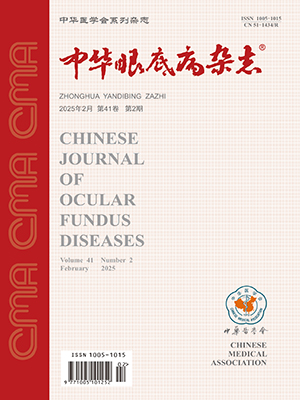| 1. |
张美霞. 关注湿性年龄相关性黄斑变性抗血管内皮生长因子治疗中的无应答病例[J]. 中华眼科杂志, 2014, 50(6): 406-410. DOI: 10.3760/cma.j.issn.0412-4081.2014.06.002.Zhang MX. Attention to the non-responders to anti-VEGF treatment of wet age-related macular disease[J]. Chin J Ophthalmol, 2014, 50(6): 406-410. DOI: 10.3760/cma.j.issn.0412-4081.2014.06.002.
|
| 2. |
宋爽, 杨帆, 谷潇雅, 等. VEGF-A基因变异对新生血管性年龄相关性黄斑变性及雷珠单抗疗效的影响[J]. 中华实验眼科杂志, 2020, 8(38): 680-685. DOI: 10.3760/cma.j.cn115989-20200509-00320.Song S, Yang F, Gu XY, et al. Effect of VEGF-A gene mutation on neovascular age-related macular degeneration and the response to ranibizumab[J]. Chin J Ocul Fundus Dis, 2020, 8(38): 680-685. DOI: 10.3760/cma.j.cn115989-20200509-00320.
|
| 3. |
van Asten F, Rovers MM, Lechanteur YT, et al. Predicting non-response to ranibizumab in patients with neovascular age-related macular degeneration[J]. Ophthalmic Epidemiol, 2014, 21(6): 347-355. DOI: 10.3109/09286586.2014.949010.
|
| 4. |
Hautamäki A, Seitsonen S, Holopainen JM, et al. The genetic variant rs4073 A→T of the interleukin-8 promoter region is associated with the earlier onset of exudative age-related macular degeneration[J]. Acta Ophthalmol, 2015, 93(8): 726-733. DOI: 10.1111/aos.12799.
|
| 5. |
Pei XT, Li XX, Bao YZ, et al. Association of c3 gene polymorphisms with neovascular age-related macular degeneration in a chinese population[J]. Curr Eye Res, 2009, 34(8): 615-622. DOI: 10.1080/02713680903003484.
|
| 6. |
Chen LJ, Liu DT, Tam PO, et al. Association of complement factor H polymorphisms with exudative age-related macular degeneration[J]. Mol Vis, 2006, 12: 1536-1542.
|
| 7. |
Liutkeviciene R, Vilkeviciute A, Streleckiene G, et al. Associations of cholesteryl ester transfer protein (CETP) gene variants with predisposition to age-related macular degeneration[J]. Gene, 2017, 636: 30-35. DOI: 10.1016/j.gene.2017.09.022.
|
| 8. |
Fauser S, Smailhodzic D, Caramoy A, et al. Evaluation of serum lipid concentrations and genetic variants at high-density lipoprotein metabolism loci and TIMP3 in age-related macular degeneration[J]. Invest Ophthalmol Vis Sci, 2011, 52(8): 5525-5528. DOI: 10.1167/iovs.10-6827.
|
| 9. |
Paun CC, Ersoy L, Schick T, et al. Genetic variants and systemic complement activation levels are associated with serum lipoprotein levels in age-related macular degeneration[J]. Invest Ophthalmol Vis Sci, 2015, 56(13): 7766-7773. DOI: 10.1167/iovs.15-17035.
|
| 10. |
Lyssenko NN, Haider N, Picataggi A, et al. Directional ABCA1-mediated cholesterol efflux and apoB-lipoprotein secretion in the retinal pigment epithelium[J]. J Lipid Res, 2018, 59(10): 1927-1939. DOI: 10.1194/jlr.M087361.
|
| 11. |
Peter I, Huggins GS, Ordovas JM, et al. Evaluation of new and established age-related macular degeneration susceptibility genes in the Women's Health Initiative Sight Exam (WHI-SE) Study[J]. Am J Ophthalmol, 2011, 152(6): 1005-1013. DOI: 10.1016/j.ajo.2011.05.016.
|
| 12. |
Colijn JM, den Hollander AI, Demirkan A, et al. Increased high-density lipoprotein levels associated with age-related macular degeneration: evidence from the EYE-RISK and European Eye Epidemiology Consortia[J]. Ophthalmology, 2019, 126(3): 393-406. DOI: 10.1016/j.ophtha.2018.09.045.
|
| 13. |
Mitchell P, Liew G, Gopinath B, et al. Age-related macular degeneration[J]. Lancet, 2018, 392(10153): 1147-1159. DOI: 10.1016/s0140-6736(18)31550-2.
|
| 14. |
Hautamäki A, Kivioja J, Seitsonen S, et al. The IL-8, VEGF, and CFH polymorphisms and bevacizumab in age-related macular degeneration[J]. Ophthalmology, 2014, 121(4): 973. DOI: 10.1016/j.ophtha.2013.11.035.
|
| 15. |
Lazzeri S, Orlandi P, Piaggi P, et al. IL-8 and VEGFR-2 polymorphisms modulate long-term functional response to intravitreal ranibizumab in exudative age-related macular degeneration[J]. Pharmacogenomics, 2016, 17(1): 35-39. DOI: 10.2217/pgs.15.153.
|
| 16. |
Georgitsi MD, Vitoros V, Panou C, et al. Individualized significance of the -251 A/T single nucleotide polymorphism of interleukin-8 in severe infections[J]. Eur J Clin Microbiol Infect Dis, 2016, 35(4): 563-570. DOI: 10.1007/s10096-015-2571-y.
|
| 17. |
Ten Berge JC, Fazil Z, van den Born I, et al. Intraocular cytokine profile and autoimmune reactions in retinitis pigmentosa, age-related macular degeneration, glaucoma and cataract[J]. Acta Ophthalmol, 2019, 97(2): 185-192. DOI: 10.1111/aos.13899.
|
| 18. |
Yang IH, Wong JH, Chang CM, et al. Involvement of intracellular calcium mobilization in IL-8 activation in human retinal pigment epithelial cells[J]. Invest Ophthalmol Vis Sci, 2015, 56(2): 761-769. DOI: 10.1167/iovs.14-15299.
|
| 19. |
Fernández-Vega B, García M, Olivares L, et al. The association study of lipid metabolism gene polymorphisms with AMD identifies a protective role for APOE-E2 allele in the wet form in a Northern Spanish population[J/OL]. Acta Ophthalmol, 2020, 98(3): e282-e291[2019-10-26]. https://pubmed.ncbi.nlm.nih.gov/31654486/. DOI: 10.1111/aos.14280.
|
| 20. |
Fritsche LG, Igl W, Bailey JN, et al. A large genome-wide association study of age-related macular degeneration highlights contributions of rare and common variants[J]. Nat Genet, 2016, 48(2): 134-143. DOI: 10.1038/ng.3448.
|
| 21. |
Wang YF, Han Y, Zhang R, et al. CETP/LPL/LIPC gene polymorphisms and susceptibility to age-related macular degeneration[J/OL]. Sci Rep, 2015, 5: 15711[2015-10-27]. https://pubmed.ncbi.nlm.nih.gov/26503844/. DOI: 10.1038/srep15711.
|
| 22. |
Teng MS, Wu S, Er LK, et al. LIPC variants as genetic determinants of adiposity status, visceral adiposity indicators, and triglyceride-glucose (TyG) index-related parameters mediated by serum triglyceride levels[J/OL]. Diabetol Metab Syndr, 2018, 10: 79[2018-11-06]. https://pubmed.ncbi.nlm.nih.gov/30410583/. DOI: 10.1186/s13098-018-0383-9.
|
| 23. |
Kunchithapautham K, Atkinson C, Rohrer B. Smoke exposure causes endoplasmic reticulum stress and lipid accumulation in retinal pigment epithelium through oxidative stress and complement activation[J]. J Biol Chem, 2014, 289(21): 14534-14546. DOI: 10.1074/jbc.M114.564674.
|
| 24. |
Downie LE, Keller PR. Nutrition and age-related macular degeneration: research evidence in practice[J]. Optom Vis Sci, 2014, 91(8): 821-831. DOI: 10.1097/opx.0000000000000285.
|
| 25. |
Cougnard-Grégoire A, Delyfer MN, Korobelnik JF, et al. Elevated high-density lipoprotein cholesterol and age-related macular degeneration: the Alienor study[J/OL]. PLoS One, 2014, 9(3): e90973[2014-03-07]. https://pubmed.ncbi.nlm.nih.gov/24608419/. DOI: 10.1371/journal.pone.0090973.
|




